Kids have the ability to learn to ride a bike as early as 12 months old.
Your toddler can already walk on his own now, which is a very important first step in his development. He now has the ability to be his own means of transportation. At this age they are ready to take on new skills. The earlier they start developing skills that involve motor tasks, the more these skills will stay implanted in their muscle memory forever.
Learning to ride a bike is a logical next step in learning to go from point A to point B on their own. Whether it be with ride-on toys, balance bikes, tricycles, or pedal bikes, the sooner they start to get the hang of it, the better they’ll be at it.
Contents
- What to Consider When Choosing a Bike Helmet
- Top 8 Bike Helmets for Toddlers 2024
- 1. Best Overall Bike Helmet for Toddlers: Joovy Noodle
- 2. Safest Bike Helmet: Giro Scamp MIPS
- 3. Trendiest Bike Helmet: Nutcase Baby Nutty
- 4. Best Premium Bike Helmet: Bell Sidetrack II
- 5. Best Budget Bike Helmet: Schwinn Infant / Schwinn Toddler
- 6. Best Night Time Bike Helmet: Lazer BOB
- 7. Lazer Lil’ Gekko
- 8. Uvex Hero Bike Helmet
- A Complete Guide to Bike Helmets for Toddlers
- Toddlers’ Bike Helmet FAQ
- Wrapping Up
What to Consider When Choosing a Bike Helmet
The helmet you choose for your little one will give you the peace of mind required to start teaching him how to develop this new skill. Helmets are constantly improving, so there are plenty of good choices for your toddler to safely start their journey towards riding a bike.
Age Range
It is important to know what age each helmet model is designed for. Some models come in a universal size, while others have separate age groups. Make sure the helmet you choose is suitable for your child. We’ve indicated in the reviews the age range that each helmet is suitable for.
Size and Weight
Measuring your child’s head before committing to buy is very important, even if the size chart states it is suitable for toddlers. The helmet should have some excess headroom so the child can gradually grow into it. This way, you won’t have to spend money on new helmets every few months.
What’s more, the more lightweight the helmet, the better. Since your toddler’s neck strength is still in development, it is not a good idea to add extra unnecessary weight on their heads.
Comfort
From the way it buckles on and off to the amount of airflow the helmet receives, comfort is a crucial characteristic to look for in helmets. You don’t want your toddler to hate wearing it. There are buckles that pinch less than others, and there are helmets with more air vents than others, so look out for these in a well-designed helmet.
Safety
All helmets sold in the U.S. are certified by the Consumer Product Safety Commission (CPSC). The CPSC has a set of standards that must be met by a product to be deemed safe enough to use.
Some helmets even have a more advanced technology called MIPS. This Multi-directional Impact Protection System reduces the impact caused by falls that happen at an angle. This technology does come at a price though.
Design and Use
Depending on the use of the helmet, there are different designs that can accommodate different styles of riding. For instance, If your little one is riding in a bike seat or in a bike trailer, you may want to consider a helmet with a flat back so that they can rest their head comfortably and enjoy the ride.
Most helmets have a nice, modern build, but some companies go the extra mile to offer attractive colors and designs – sometimes even altering the regular shape of a helmet to make it stand out more.
Now it’s time to show you all the best helmets available on the market today. We took all the important criteria into consideration to make it easier for you to decide. Each helmet is a popular choice for its uniqueness and reliability.
Top 8 Bike Helmets for Toddlers 2024
1. Best Overall Bike Helmet for Toddlers: Joovy Noodle
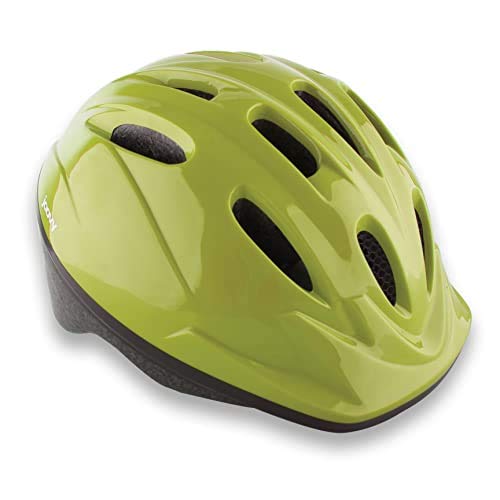
Editor’s Rating:
Quick Facts
- Age Range: 1 – 4 years old
- Dimensions: 18.5 – 20.5 inches
- MIPS: No
Safety
The Joovy Noodle is CPSC-compliant. Its hardshell construction is composed of a plastic shell that is glued over a piece of solid foam. This hardshell build can get cracked or get unglued over time, which is somewhat of a drawback. It doesn’t happen soon after the purchase, but the damage is more inevitable than with other shells.
It’s not a MIPS helmet however. If you want the latest in technological safety, the Giro Scamp is the one to go for.
Comfort
Because the Joovy Noodle has been designed especially with toddlers in mind, the helmet also has more stability on small heads. A major draw to this helmet is the reduced time it takes to put the helmet on and take it off.
It has dual-colored chin straps, with a soft pad underneath, that make the buckle easy to spot (the left one is black, the right one is red) and thus put on an impatient toddler’s head without losing too much patience.
The chin buckle also has a pinch guard to protect your toddler or your fingers from those annoying pinches when you’re putting the helmet on in a hurry. There are 14 vent holes that keep your toddler’s head ventilated during the summer.
Size and Weight
This helmet comes in two sizes (XS/S and S/M) out of which the XS/S is perfect for toddlers. It suits heads that measure between 18.5 and 20.5 inches. The chin straps are not the sturdiest, but they serve an important role in finding the perfect fit for your child, as they are brought together by the dial-adjust fit system in the back.
At only 8 ounces, the Joovy Noodle is the lightest helmet on our list, and is perfect for a toddler.
Design and Use
The Joovy isn’t particularly practical for more extreme forms of biking, such as BMX or mountain biking. It’s unlikely, however, that your toddler will be participating in those. Instead, its classic look features a visor that keeps the sun away from your toddler’s eyes on those hot days, and can also serve as extra protection in case of a fall.
Another cool feature is the mesh that covers the front vent holes that prevent bugs from flying inside as your toddler rides. And the vents are small enough so that rain won’t completely soak their head if they catch a short, unexpected shower while out.
Value
It is a very affordable helmet that comes in 7 bright colors of your choice. No fancy color combinations here; you just get a classic helmet with a classic look. For personalization, you can put stickers on.
- Affordable
- Lightweight
- Fit adjusts easily
- Front vents have bug mesh
- Solid, large single padding piece which is difficult for toddlers to remove
- The chin straps are not very secure and tight
- The chin strap pad is too long, therefore not very useful
- The hardshell is prone to cracks and damage
2. Safest Bike Helmet: Giro Scamp MIPS
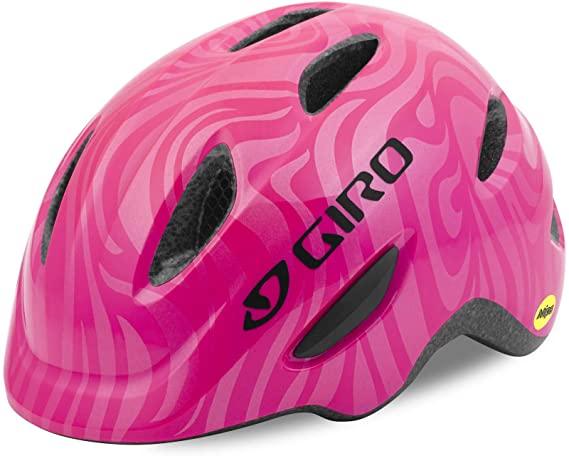
Editor’s Rating:
Quick Facts
- Age Range: 1 – 5 years old
- Dimensions: 18 – 21 inches
- MIPS: Yes
Safety
If you see the term “MIPS” written on any helmet packaging, you can be sure that the technology of the helmet is top-notch. The Multi-Directional Impact System cuts down the risks of severe damage that a person can suffer as a result of a fall. In addition, the Scamp is made of in-mold construction, which is the most durable material for a helmet. So in regards to safety, the Giro Scamp ticks all the boxes.
Comfort
This helmet will sit comfortably on top of your toddler’s head, due to its Roc-Loc Jr. dial-adjust fit system that provides the snug fit necessary for a comfortable riding experience. Although it has a pinch-guard, the plastic buckle can still pinch your toddler if the straps are tightened too close to the neck. However, it does have a rubberized adjustment knob that’s a cinch for parents to tighten securely. Another discomfort is caused by the straps that tend to loosen during rides. They need occasional on-the-go adjustment, which can be frustrating.
One of the vent holes in the back is designed for ponytails, which makes the helmet a great choice for girls. In total, the Scamp has 8 holes for ventilation. That’s not a lot of holes, so the helmet may be more suitable if your toddler rides in cooler areas or times of the year.
Size and Weight
The helmet comes in sizes XS and S. The XS is perfect for toddlers between 1 and 2 years of age, whereas the S can be purchased to make the natural transition with the same helmet, that can grow with your little one till they turn 5.
Given that the MIPS adds a little weight – totally worth it for the feeling of safety – the Scamp weighs 17 ounces, which is still comfortable enough for your toddler’s neck.
Design and Use
From its built-in visor to the ponytail-friendly design, this helmet is an elegant choice for any kid that wants to look cool as they ride. The design resembles that of an open-face mountain bike helmet, but its flat back makes it suitable for your toddler to comfortably rest their head on a bike seat or in a trailer.
Besides the visor, the matte finish is effective in deflecting excessive heat on a sunny day. From experimenting on a balance bike to trying out the first training wheels, the Giro Scamp is a great helmet to start with.
Value
Without the MIPS safety technology – which is also an option – the Scamp would be a very reasonably-priced helmet. With its increased price tag that covers the MIPS, it is still an affordably-priced mid-range helmet. There are lots of cool classic color choices your toddler can resonate with, all with an elegant matte finish.
- Affordable
- MIPS Safety
- Comfortable
- Matte finish keeps the head cooler during sunny days
- Straps require occasional adjusting
- Plastic buckle system can pinch
- Padding is a bit thin
- Not very ventilated
3. Trendiest Bike Helmet: Nutcase Baby Nutty
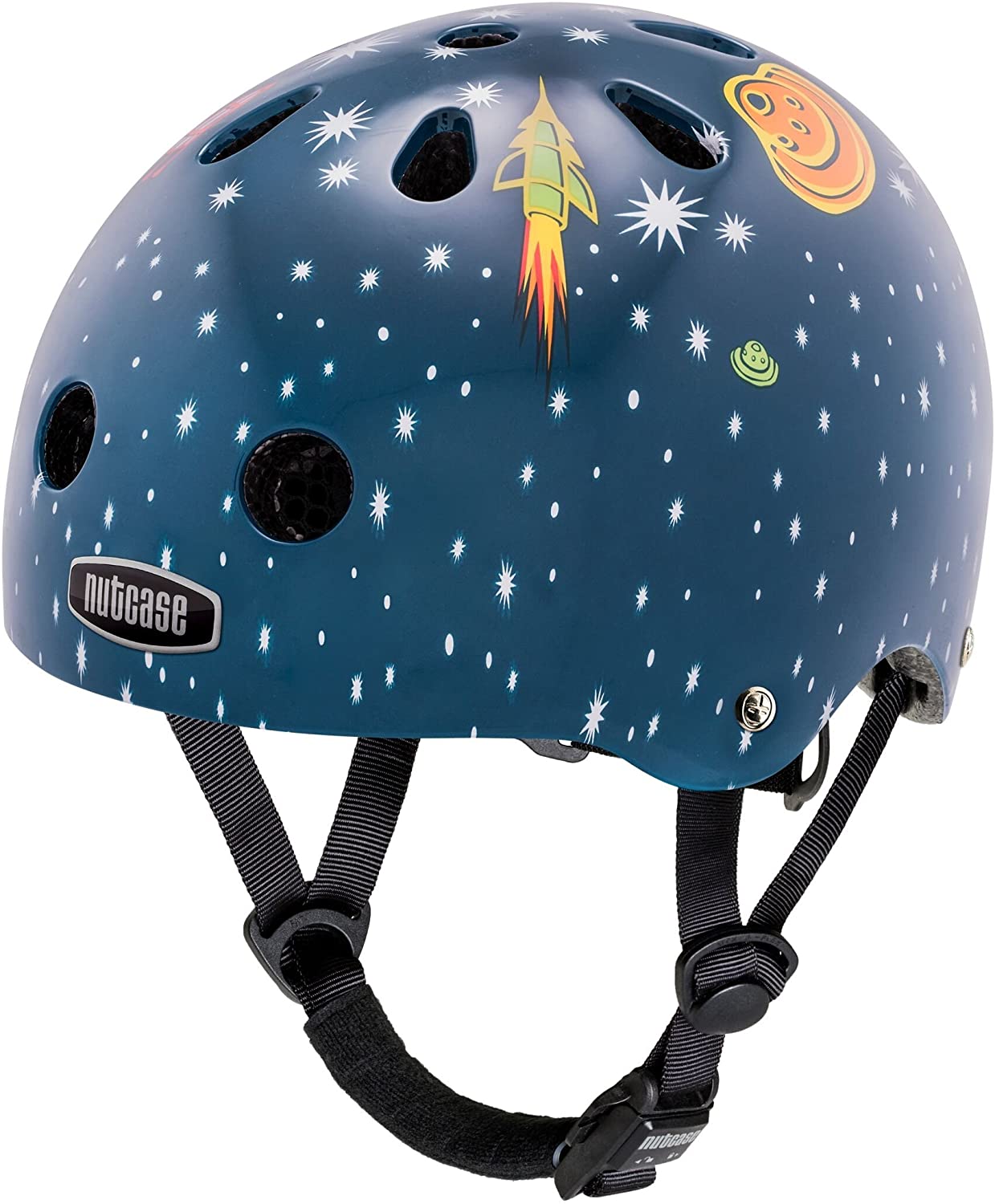
Editor’s Rating:
Quick Facts
- Age Range: 1 – 3 years old
- Dimensions: 18.5 – 19.5 inches
- MIPS: No
Safety
This helmet provides all the safety you’d want short of going for a MIPS helmet. It is CPSC 1+ certified, and the plastic shell that covers the protective EPS foam underneath is thick enough to withstand any accidental drops. In fact, it is so solid, that its technology resembles that of a football helmet.
Comfort
Besides the internal padding that keeps the helmet snugly on your toddler’s head, the Baby Nutty also has an elastic adjustment system. While dial-adjust systems may last longer, elastic adjusters are quicker and easier to use, which is a great feature for impatient toddlers.
You won’t have to worry about pinching your toddler’s skin while fastening the helmet on their head, as the Baby Nutty has a soft-padded magnetic buckle that prevents pinching and lets the chin straps sit comfortably under the neck. Unfortunately, the chin straps tend to loosen after many uses.
The helmet offers less comfort for toddlers riding in areas with hot climates, or on sunny summer days, as it only has 11 vents. Although the front vent holes are covered with bug mesh to keep insects away from the helmet’s interior while in motion, they are still not enough to offer sufficient airflow in hot climates.
Size and Weight
If your child grows attached to the Baby Nutty, as we think he or she will, you can later purchase the successor model, the Little Nutty. The line goes up to teenagers too with their Nutcase Street offering. This basically means that the Baby Nutty is a size XXS, the Little Nutty is an XS, whereas the Nutcase Street is an S, so there would be no problem finding the perfect fit for your child.
Some helmets, such as the Baby Nutty, advertise their use for toddlers as young as 9 months old, but we recommend holding off any form of riding till they turn one year old. Toddlers’ necks are still gaining strength, so it’s best to wait until 1 year before wearing this 10-ounce helmet.
Design and Use
The design of the Baby Nutty makes it suitable for biking, rollerblading, skating, and riding scooters. Furthermore, its flat back makes it comfortable to wear when riding on bike seats or in trailers. Not only is the back flat, but it also offers a little extra coverage in case of a fall.
Value
While it is not the most affordable helmet on the market, it offers more than what other helmets in this high-end price range do. The attractive designs are a big part of the salty price tag. Parents should be worried about safety primarily, but toddlers are hypnotized by the look of a helmet. Wearing a cool-looking helmet is very important for children, as they can create micro-trends among themselves and their parents. This is exactly what the Baby Nutty can do.
- Lightweight
- Magnetic chin buckle with soft padding underneath
- Efficient elastic adjustment system
- Flat back makes it suitable for many ways of riding
- Not cheap
- Chin straps tend to loosen in time
- Not too much ventilation
4. Best Premium Bike Helmet: Bell Sidetrack II
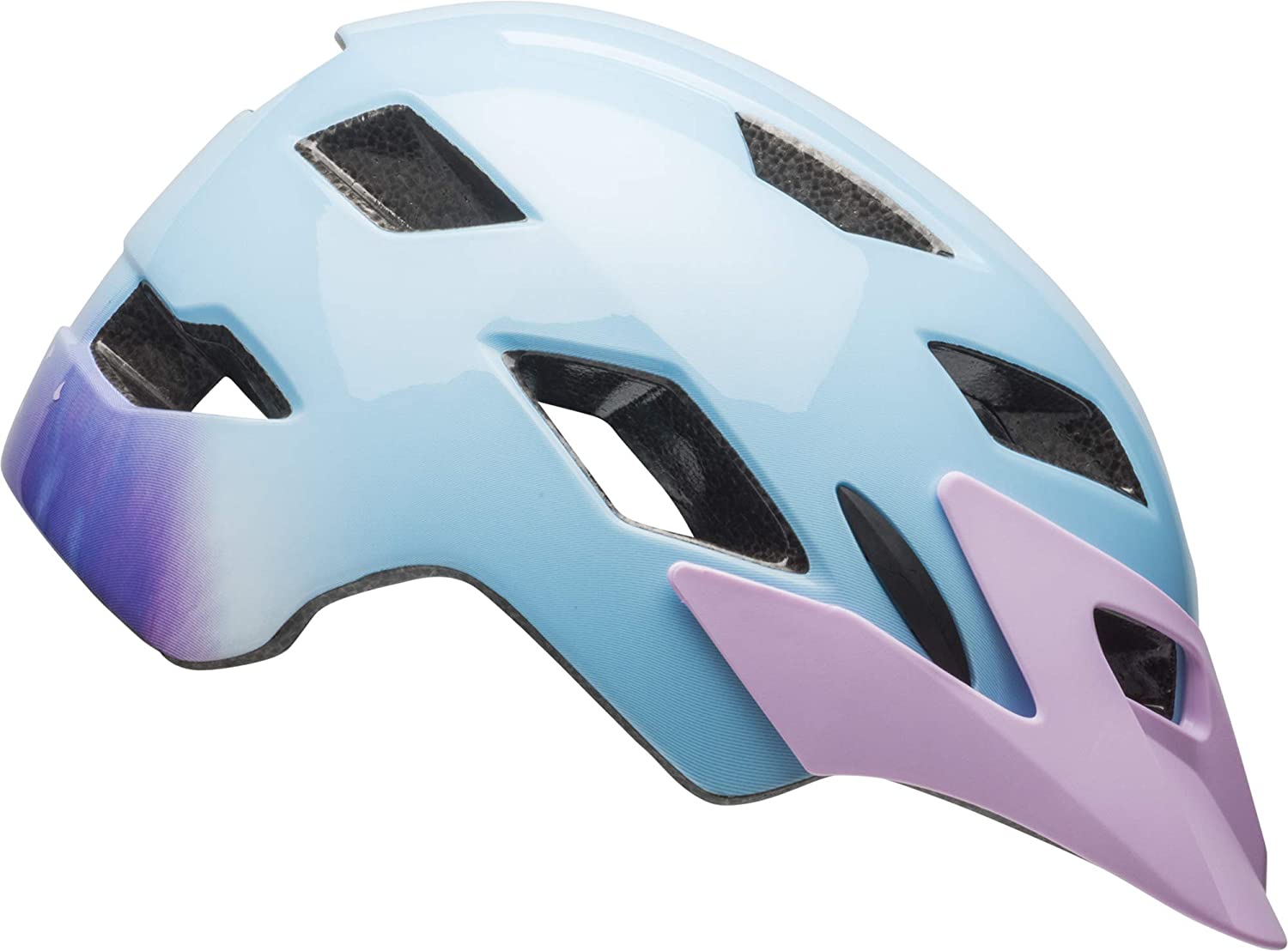
Editor’s Rating:
Quick Facts
- Age Range: 3 – 6 years old
- Dimensions: 18.5 – 21.5 inches
- MIPS: Yes
Safety
The Bell Sidetrack II comes with the option of MIPS technology, which we highly recommend, as it is the most modern safety technology on the market. The in-mold construction, which all durable bike helmets are made of, covers a shell that has both great front and rear head protection.
Comfort
The dial-adjust system on the Sidetrack II saw an improvement from the previous ErgoDial system that the Sidetrack I had. The newly-christened ErgoFit adjusting system doesn’t have to be pushed to turn it. Although it can be a little tricky to adjust on a small head, the full cage is adjustable by twisting the dial behind it, where the head is comfortably enclosed for a snug fit.
The Sidetrack II has 15 large vent holes, including internal air channels, that provide plenty of ventilation on hot days. Bell could’ve, however, invested a bit more in the buckle system. Although it has a pinch-guard, the straps can get entangled and are way too long and dangle on the sides as a result. But you can cut off the extra straps until they are no longer a problem for your little one.
Size and Weight
The Sidetrack II comes in 2 sizes, Universal Child and Universal Youth. The Universal Child size is the optimal one for toddlers ranging between ages 3 and 6. The helmet is one of the lightest on our list, coming in at 9 ounces. There is also a Universal Toddler size, which ironically, we don’t recommend, due to the ErgoFit adjust system that is placed too high on the helmet and you can’t comfortably fit fingers around to adjust it.
Design and Use
The Sidetrack II has an open-face mountain bike style. The rear of the helmet is flat enough to be worn in a trailer or on a bike seat, but doesn’t cover much. It has a removable snap-in visor in the front which blocks out the sunlight on hot days. Its main use is on a bike, whether it be with training wheels or a balance bike. Since it’s designed for toddlers 3 years old and up, you should consider buying it only when you are sure your little one will definitely pursue biking and not another sport that requires a different helmet. This is a biking helmet only.
Value
For such an esteemed helmet brand like Bell, the Sidetrack II is priced very reasonably. You have the option of saving a $20 bill by not including the MIPS system. However, we encourage you to buy it with the MIPS. It is still affordable, and it comes in 10 attractive colors you can choose from.
- MIPS safety technology
- Lightweight
- Not too expensive
- Great ventilation
- Durable
- Visor is too easily removable
- Buckle takes some time to adjust and figure out
- Toddler size doesn’t suit the ErgoFit adjust system
5. Best Budget Bike Helmet: Schwinn Infant / Schwinn Toddler
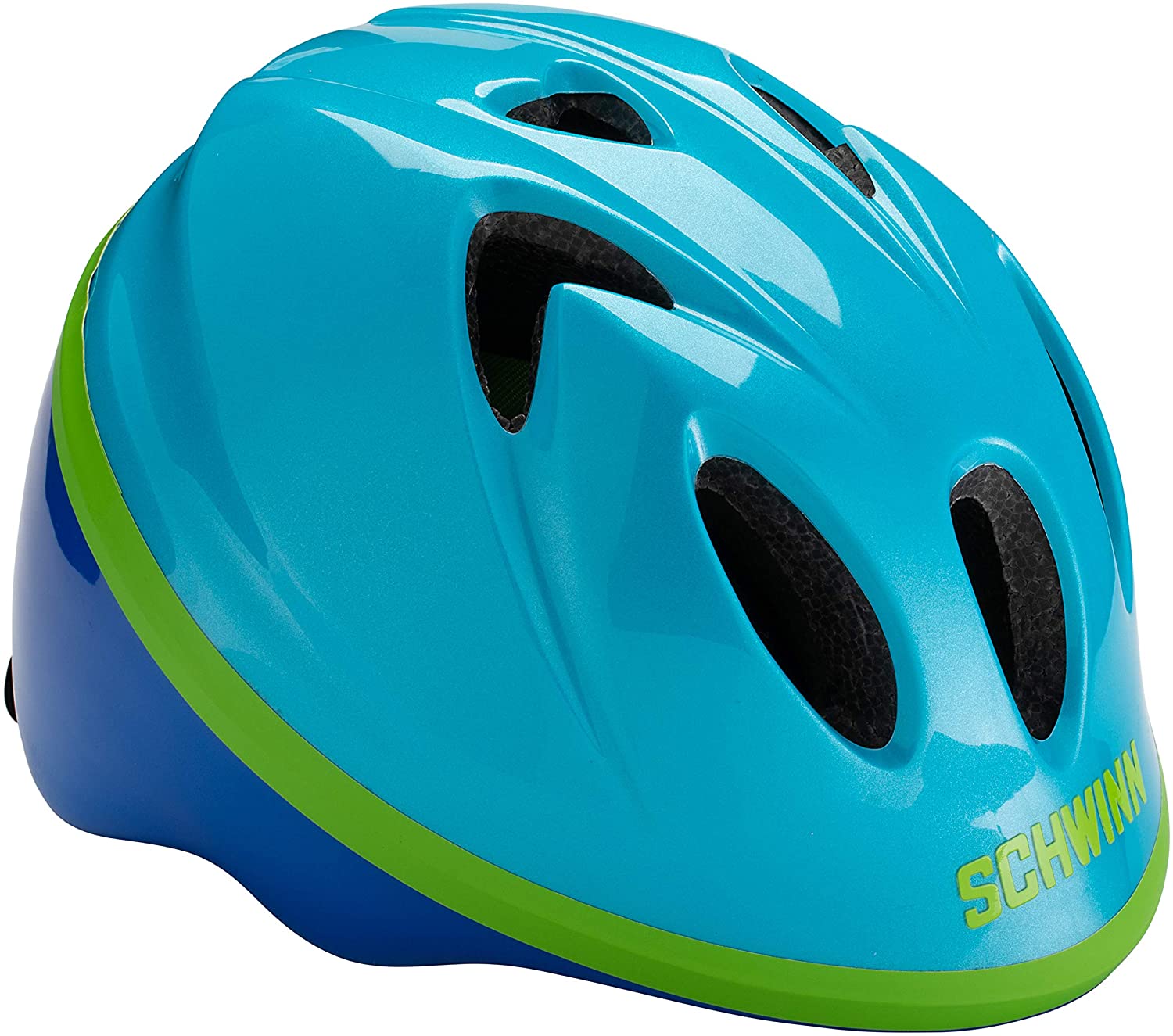
Editor’s Rating:
Quick Facts
- Age Range: 1 – 5 years old
- Dimensions: 17.5 – 20 inches
- MIPS: No
Safety
The Schwinn helmet is CSPC 1+ certified. The inside of the helmet has extra padded coverage and an additional molded shell for increased safety and security. The pads could be a little more robust, though.
Comfort
This helmet has a very effective and easy-to-use dial-adjust system, which doesn’t irritate or dig into your toddler’s neck. It sits comfortably on your child’s head and doesn’t feel like it is too large. Although 8 vent holes might not seem like much, they are large and well-placed to ensure a decent amount of airflow. In addition to that, the integrated visor keeps the sun rays away when it’s hot outside.
Size and Weight
Not only is it the smallest, but it may also be the lightest helmet on our list, weighing only 8 pounds.
The Schwinn is deeper than other helmets, so if your kid has a taller, more narrow head, this helmet should suit them perfectly. On the other hand, the helmet can impair your child’s range of vision if they have a short forehead, because it will sit low in the front. It would be easier if Schwinn would have provided an accurate measurement chart so you won’t have to judge these features by eye before purchasing the helmet.
Design and Use
This is a classic bike-style helmet with a flat back that is perfect for riding in a trailer or on a bike seat, or even training to ride a real bike. The inside of the helmet has an adjustable band that allows the helmet to grow with your child for a while.
Value
It would seem like this is a pretty mid-to-high-end helmet, right? Well, it is lower than admission for two at the movie theater, and it is much better than a generic helmet you would find at Walmart. Plus, the designs it comes in are super cute and suitable for both boys and girls, and don’t seem cheap at all.
- Very affordable
- Lightweight
- Dial-adjust system
- Cool colors and designs
- Good coverage
- Pads are not soft
- Pads aren’t properly glued
- No proper measurement chart provided, so it could be too small or narrow for some heads
6. Best Night Time Bike Helmet: Lazer BOB
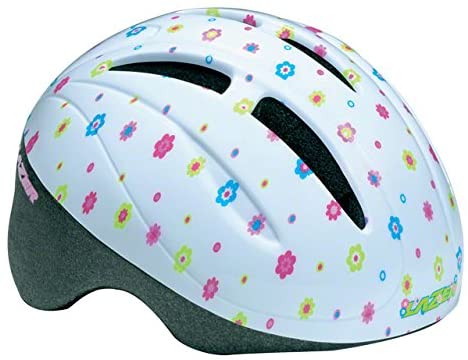
Editor’s Rating:
Quick Facts
- Age Range: 1 – 3 years old
- Dimensions: 18 – 20.5 inches
- MIPS: No
Safety
All helmets sold in the U.S. are CPSC-certified. Some, however, are CPSC +1 compliant, like the Lazer BOB. The “+1” means additional rear and neck coverage, which is essential in case of any fall, especially for a toddler.
Comfort
The Lazer BOB rests comfortably on your toddler’s head, thanks to the extra support provided by the soft padding and neck reinforcement. The soft-pads are removable and can be cleaned. There are only 6 air vents for ventilation, so it tends to get sweaty inside the helmet. There is additional padding around the chin to keep it a bit cooler on hot days. It would have been even better if the buckle didn’t pinch, as the neck and chin areas are sensitive, especially for a toddler.
Size and Weight
This helmet comes in one size, which is easily adjustable due to its Comfit3 Retention System, placed in the back. The only problem with that is the fit for toddlers with smaller heads; the retention system will just sit loosely on the head, as it lacks a dial that can tighten the fit. And even for kids with a larger head size, the Comfit3 is just a plastic tab on a band, which tends to loosen in time. Luckily, the sliders on the straps stay in place and don’t need on-the-go adjustments.
Design and Use
What makes this helmet stand out from the others is the 360 reflective tape that ensures high visibility at nighttime. This means that if they ride at night, your toddler is visible to any cars or bikes that may pass by, which can prevent accidents. The flat back of the helmet makes it suitable for riding comfortably on a bike seat or in a trailer.
Value
The Lazer BOB is a very affordable helmet that comes in a variety of cute patterns for boys and girls alike. In addition, you also get extra pads you can use to swap out the ones that need to be washed after sweaty days out riding in the sun.
- Affordable
- 360-degree reflective tape for maximum nighttime visibility
- Good rear and neck coverage
- Straps stay in place
- Not that easy to adjust
- Weak ventilation
- Comfit3 adjustment band tends to loosen
7. Lazer Lil’ Gekko
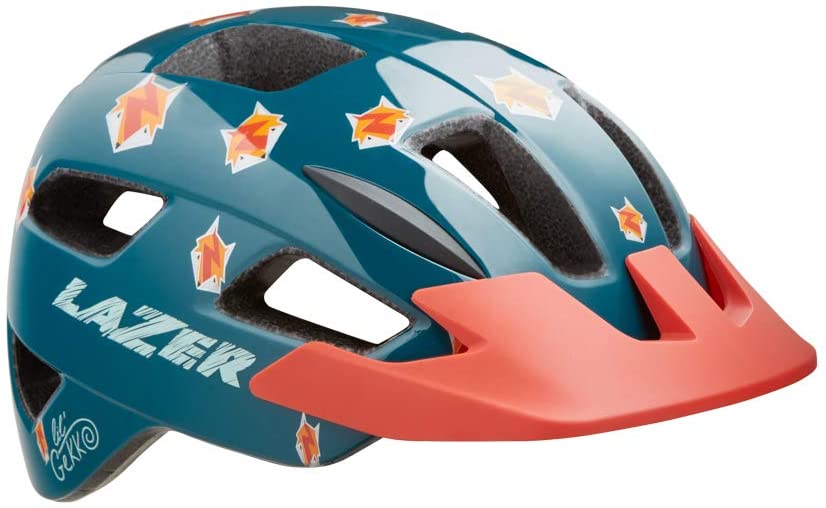
Editor’s Rating:
Quick Facts
- Age Range: 1 – 3 years old
- Dimensions: 18 – 19.5 inches
- MIPS: Yes
Safety
This helmet comes with optional MIPS technology, and is CPSC +1-certified, which means it offers more rear and neck coverage. Normally, we would encourage you to purchase the MIPS version, but there is a slight difference in size and weight between the MIPS and non-MIPS versions.
Another slight problem with the MIPS version is that the anchors are not sealed, so they might snag on long hair. We don’t recommend the MIPS version for girls or boys with long hair.
The shell is made of in-mold construction, which fuses the outer shell with the inner EPS foam liner, for a sturdy build.
Comfort
What sets the Lil’ Gekko apart from other helmets is the AutoFit system Lazer came up with. Unlike other high-end helmets that tighten from the back, the Lil’ Gekko has an internal cage that adjusts based on your child’s head, without any preliminary adjustments. This technology is based on a tension wire system, making the inner cage adaptable to your child’s head.
The AutoFit system works even better on short hair, low ponytails, or low braids; otherwise it has the tendency to slide around if your toddler has a head with loose long hair.
The buckle system is another thoughtful feature, although it’s sadly made of plastic. It is located on the side of the face, rather than underneath the chin, so there’s never the risk of pinching your toddler’s neck when fastening his helmet on.
The pads on the inside are sealed so as to prevent hair snagging, and the helmet has 12 long vents that ensure good airflow.
Size and Weight
For children with round or wide heads, we recommend passing on the MIPS option for the Lil’ Gekko. The MIPS version is much better for kids with taller, more narrower heads. Don’t worry, the helmet is still sturdy without the extra protection.
With the MIPS the helmet weighs 11.5 ounces, whereas without it, it only weighs 10.5 ounces. Both versions are lightweight enough that they won’t burden your little one’s neck.
Design and Use
Although mountain bike style helmets usually have a somewhat pointy back, the Lil’ Gekko has a flat enough rear to comfortably suit a toddler sitting in a bike seat or in a bike trailer. Like all high-end mountain bike helmets, this one has a removable visor that is great for blocking out the sun from your toddler’s eyes. It is even sturdy enough to reduce the impact in the unfortunate case of a face plant.
Value
This helmet falls in the mid-range price point. Normally, a MIPS system costs around $20 extra. However, the Lil’ Gekko only costs half of that price to add, which means that – should you go for that – you’re getting a good deal.
- AutoFit adjustment system ensures a perfect fit
- Pinch-free position of the buckle
- Durable, with an optional MIPS technology
- Well-ventilated
- AutoFit system may slide to either side of the head, for long-haired toddlers
- Not cheap
- MIPS anchors are exposed, which can snag the hair
- MIPS changes the way it fits on the head, which only suits a certain type of head shape
8. Uvex Hero Bike Helmet
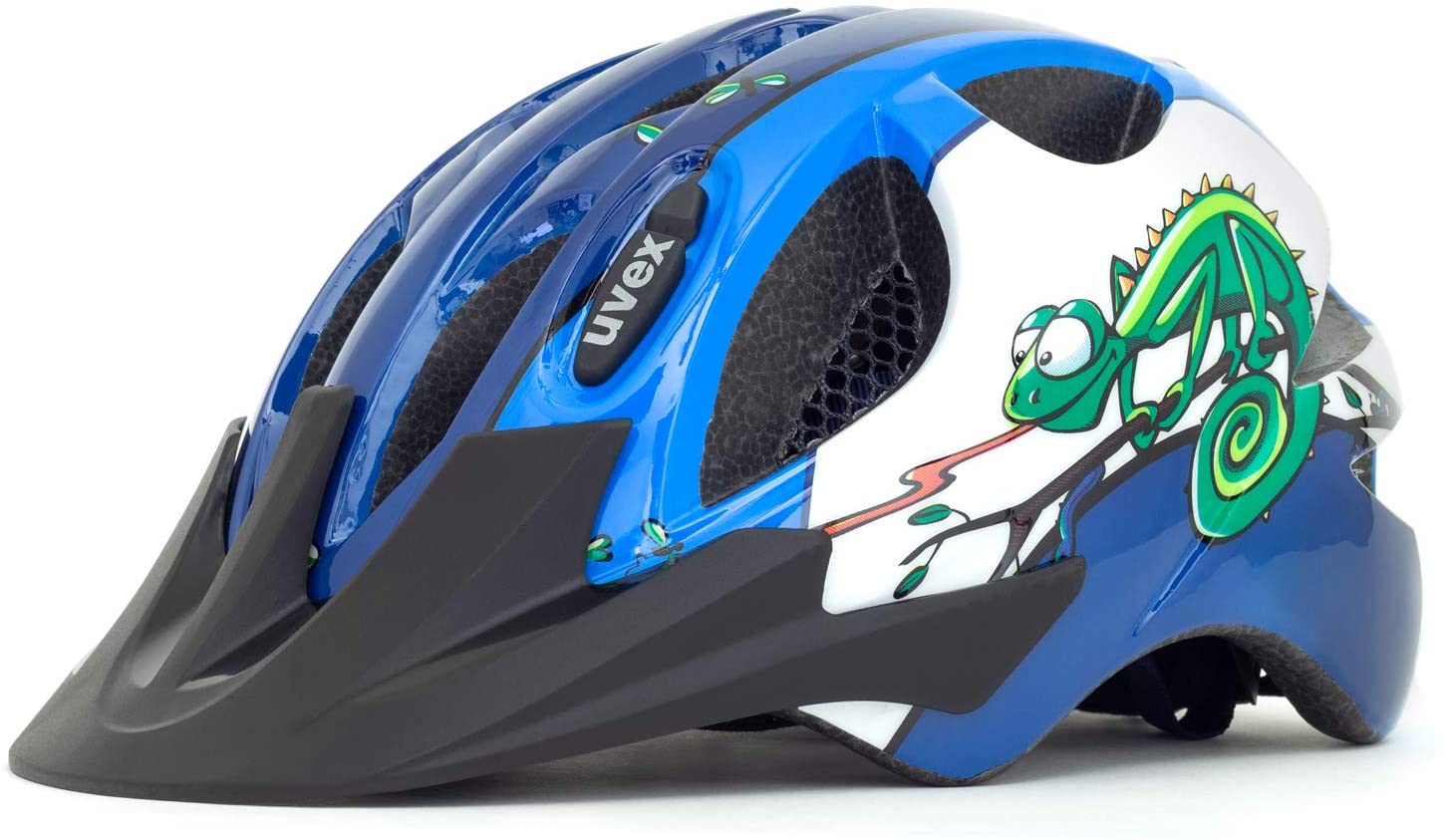
Editor’s Rating:
Quick Facts
- Age Range: 2 – 5 years old
- Dimensions: 19 – 21 inches
- MIPS: No
Safety
This helmet is made of in-mold construction, which makes it both durable and lightweight. It is CPSC-compliant and is thick enough to not crack easily.
Comfort
Gone are the annoying moments when the buckle pinches the neck of your toddler. The Uvex Hero offers its own ratcheting, which closes slowly rather than aggressively snapping into place. This “monomatic” buckle is the most pinch-free out of all the other helmets that advertise this. The helmet also fits easily due to its dial-adjust system.
Size and Weight
The Uvex Hero is perfect for toddlers with round heads, rather than those with tall foreheads. As your child grows, they can graduate to the Uvex Quatro Junior, which still features the unique buckle system of the Hero but also offers a bit more depth in size. The helmet only weighs 9 ounces, which is a perfect weight for a toddler’s bike helmet.
Design and Use
This helmet is designed like an open-face mountain bike helmet, and even features a removable visor that protects your toddler’s eyes from the sun’s rays. Its 13 vent holes are all mesh-lined to keep insects out.
Value
The Uvex Hero is great value for money. Yes, it’s on the higher end of the scale, but the features and considerations behind the design make it well worth the money.
- Affordable
- Lightweight
- Pinch-free ratcheting buckle design
- Durable construction
- Not suitable for kids with tall foreheads
- Back is not flat enough for toddlers to comfortably ride in a bike seat or a trailer
A Complete Guide to Bike Helmets for Toddlers

Buying a helmet for a toddler is different than buying a helmet for an adult, or even a kid. There are slightly different features to consider. It all boils down to answering two fundamental questions you should ask yourself: Is it comfortable for my toddler to wear? And is it safe for my toddler to wear?
Safety
All bike helmets sold in the U.S. must be compliant with a set of criteria set out by the Consumer Product Safety Commission. Some helmets are even CPSC +1-certified, where the “+1” means a bit of extra coverage on the back, and down towards the neck. Our best budget pick, the Schwinn Toddler, is an example of a CPSC +1 certified helmet.
The most modern safety technology is the MIPS. The Multi-Directional Impact Protection System is an additional head cage placed in the interior of a helmet, that allows more space for the head to move in during a fall, which reduces rotational forces that are unhealthy for the brain. Our safest pick, the Giro Scamp, incorporates MIPS technology very successfully into its design.
A toddler’s head and neck are still in development when it comes to strength, balance, and stability. Therefore, doctors recommend using a helmet when toddlers are doing risky things like riding a bike – even at low speeds. Concussions and head injuries are no joke at any age, but toddlers in particularly need to be protected against such eventualities.
Comfort
Luckily, there are ways for toddlers to get the hang of biking without actually being exposed to these risks first-hand. They can ride in bike trailers or on bike seats with mom or dad, and enjoy the thrill of motion and the fresh air, while you do all the work. Helmets such as the Giro Scamp or the Nutcase Little Nutty have a flat back so your child can comfortably sit with their heads resting against the back of a seat or a trailer.
The buckling and fitting systems can be deal-breakers. If the helmet isn’t comfortable enough to put on and wear, your child may resent or resist using it, or perhaps even take it off when you are not looking.
Some helmets like the Uvex Hero have fastening systems that are truly pinch-free, while others have invested a little more into making the chin straps more durable and less rigid, so as to not irritate your little toddler’s sensitive skin. Most helmets come with a dial-adjust system, which is easy to set to sit snugly on your little one’s head.
The number of vents is also important, since riding can be a tiring task, especially if it’s done out in the sun. The head needs to breathe as much as possible, so the more vent holes a helmet has, the better the airflow.
Some helmets have fewer holes that are actually larger than other ones, so this is a feature that differs from one model to another. Mountain bike styled helmets usually are designed with this feature in mind.
Toddlers’ Bike Helmet FAQ
What’s the Difference in Safety Between CPSC-Certified Helmet and One With MIPS Technology?
Some experts still debate the level of protection in an MIPS, and whether it is only a fancy way of raking in an extra few bucks. While the damages of an angled fall and rotational forces are real, if a nasty accident were to happen, there wouldn’t be much difference in the state of both helmets, post-fall.
How Important Is the Weight of a Helmet?
It is important for a bike helmet to be as light as possible, as a toddler’s neck still doesn’t have enough strength to hold something bulky like a heavy helmet. The more vents a helmet has, the lighter it is. The in-mold construction also makes a helmet lighter than hardshell construction. Anywhere between 8 and 10 ounces is a perfect weight.
What’s My Toddler’s Head Size?
Measuring your child’s head is very important, because not all helmets for toddlers have the same diameter and depth. Some helmets are designed for small heads, while others start at the age of 3.
The way to measure your child’s head is to take a measuring tape and wrap it around your child’s head, holding it at a distance of two fingers above his eyebrows. Make sure the measuring tape goes straight around the head, and you will know what dimensions to look for. Here is a video on how to properly measure your toddler’s head in three easy steps.
Wrapping Up
It is very important to invest in a helmet that is easy to put on and also looks good to them. That way, your young one will be inspired to use it, and not take it off when you’re not looking. If you found out their exact head dimensions, know the safety level you want and the features you are looking for, but you still are having trouble deciding on which helmet would be best – then try having your little one look at the pictures of your top choices. Choose the one which causes the biggest smile when they see it.
